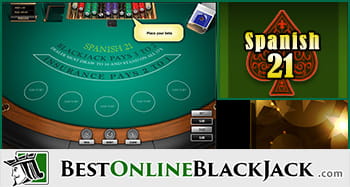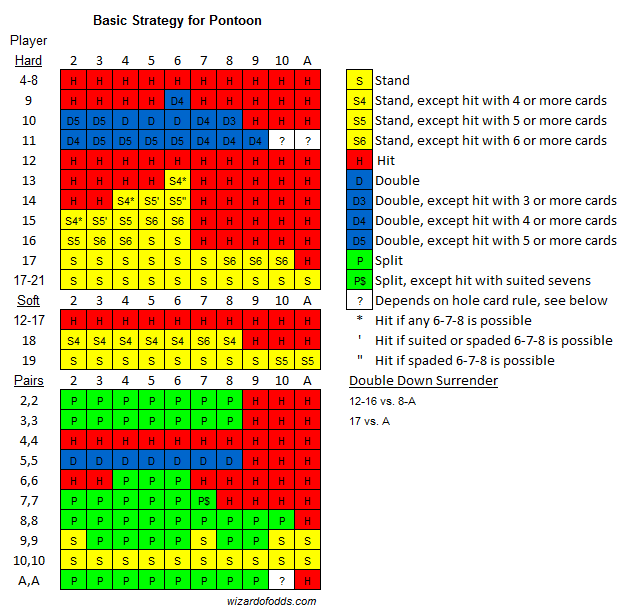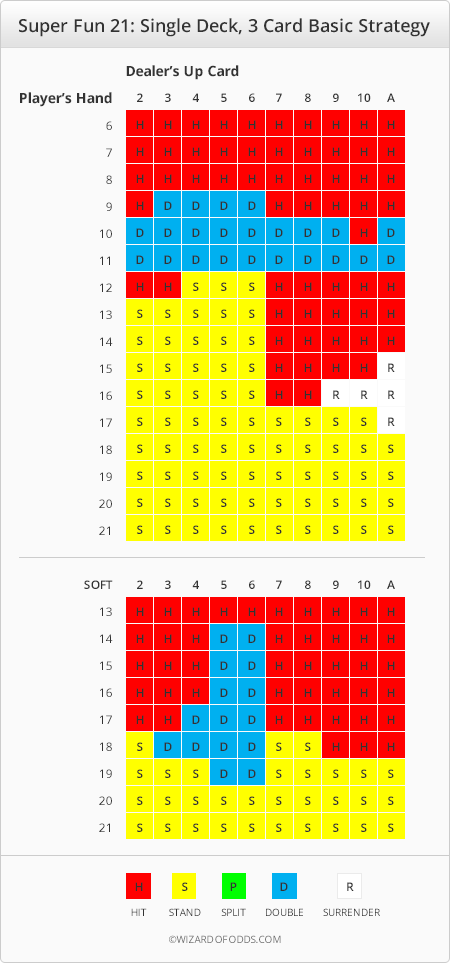Spanish 21 Strategy Chart
- Basic Strategy For Spanish 21
- Spanish 21 Strategy Chart Printable
- Spanish 21 Strategy
- 21 Basic Strategy Chart
- Spanish 21 Strategy Chart
- Spanish 21 Strategy Chart
Most people recognize that unlike many casino games, blackjack is a game of strategy. It’s immediately obvious when you sit down to play a little blackjack; players have to make a large number of decisions on almost every hand, and the choices you make often make the difference between winning and losing.
Generate custom-made strategy charts and print free strategy cards for blackjack and Spanish 21. Customize the rules and the number of decks.
Blackjack strategy can be broken down into two major components: basic strategy and card counting. Basic strategy comprises all of the playing decisions a player should make in order to keep the house edge as low as possible. In other words, a basic strategy chart would tell you the mathematically best play in every possible situation you might encounter during the course of play.
Every good blackjack strategy starts with a full understanding of basic strategy. Without that foundation, other, more advanced strategies – namely, card counting strategies – will fail, as players will simply make too many basic mistakes to overcome. On the other hand, learning just basic strategy will allow you to go into any good blackjack game getting excellent odds, sometimes good enough that you’ll show a profit with the help of comps and other rewards programs. With that in mind, it’s always better to focus on learning basic strategy first, until you feel completely comfortable with it.
- Spanish 21 Basic Strategy The game Spanish 21 is a variation of blackjack, that in some cases is the best bet in the casino. When the dealer stands on a soft 17, or redoubling is allowed, Spanish 21 may be a better bet than blackjack, but that all depends on the specific rules on where you are playing.
- Luckily, it isn’t too hard to find strategy charts for Spanish 21 online, and that is a much better option than either trying to memorize the correct plays or figuring it out as you play. This is an especially smart idea in this game, because the odds are sometimes even better than in standard blackjack, with house edges of less than 0.5%.
Editor’s Picks for Best Online Blackjack in 2020

- RTG Blackjack
- ViG Live Blackjack
- BTC Bonuses

- Live Dealer Blackjack
- 24/7 Live Support
- Trusted since 2007
- Online and mobile blackjack
- Great for U.S. based players
- New and fresh
- Classic & progressive blackjack
- Weekly blackjack tournaments
- Great for U.S. based players
$4,000
Blackjack Basic Strategy
A full basic strategy is quite complex since there are countless situations you could face during a blackjack hand that must be accounted for. There are several factors the player must take into account on each hand:
- The rules of the blackjack game they are playing;
- The score of their hand;
- The dealer’s up card;
- Whether they have the option to split and/or double.
The rules are particularly important because even small changes in the rules being used can noticeably change proper basic strategy. For instance, the right plays against a dealer that must stand on all 17s are not the right plays against a dealer who hits on soft 17. The number of decks, the ability to surrender (as well as when surrendering is offered) and other factors can also affect basic strategy.
With this in mind, it is very hard to suggest a single basic strategy that will work in any situation, especially in the scope of this article. Not only is basic strategy rather complex, but there are also countless versions of the rules which affect what basic strategy you should choose. Full basic strategy charts are available at my casinos (which don’t mind you playing basic strategy, since the casino will still hold a small edge), as well as in many great blackjack books and on some gambling websites.
Simplified Blackjack Strategy
On the other hand, it is fairly easy to suggest a simplified strategy that can help you get started in just about any typical blackjack game. This easy to memorize strategy won’t get you exactly the same odds as a full basic strategy chart, but you won’t be giving much up; the difference in the house edge until typical rules should be .2% or less when compared to perfect, optimal play. To give credit where it is due, this strategy is heavily based on one suggested at wizardofodds.com, an excellent gambling information site. Simply follow the few rules below, and you’ll avoid ever making any major blackjack mistakes!

- Double down if you have a 10 or 11 and the dealer has an up card that is worth less than your hand. Also double down with 9 if the dealer up card is a 3, 4, 5 or 6. In all cases, if you cannot double down, hit instead.
- With all other hands of 11 or less, hit.
- With hard hands of 17-21, always stand.
- With hard hands of 12-16, stand if the dealer is showing a six or lower, except hit hard 12 against the dealer’s 2 or 3. Hit if the dealer is showing a 7 or higher.
- With soft hands of 15 or lower, always hit.
- With soft hands of 19 or higher, always stand.
- With soft hands of 16-18, hit against a seven or higher, and double down if the dealer is showing a six or lower. If you cannot double down, hit instead.
- Always split eights or aces.
- Never split fours, fives, or tens.
- With all other pairs, split if the dealer is showing a six or lower, otherwise, play the hand according to the rules above, depending on your hand’s value.
- Never take insurance or “even money” on blackjacks – it is a sucker bet for the basic strategy player.
There you go! Eleven simple rules that will have you playing blackjack like a pro – or at least, close to it. This is a perfect strategy for anyone looking to quickly learn how to play blackjack very well, without taking the time to memorize an entire basic strategy. In addition, the simplicity of this system means you’re not likely to make mistakes at the table because you forget the correct play.
Card Counting
Many players aren’t content with simply minimizing the house edge. Instead, they want to have the edge for themselves! In blackjack, this is actually possible thanks to card counting.
Card counting works by tracking which cards have come out of the shoe. Because there are a limited number of cards available, it is often the case that the remaining cards in the shoe don’t actually resemble a random assortment. There may, for instance, be a case where very few tens come out on the first few hands of a new shoe. This tells us that the remaining shoe is very rich in tens, which is great for the player.

In general, tens and aces are the best cards for the player to have remaining in the deck, while low cards are the worst for the player. Card counters take advantage of this fact by wagering more money when they know that the deck is rich in cards that are good for the player. They also make other adjustments, such as taking insurance (normally a sucker bet) when the deck is very rich in tens, and occasionally changing their basic strategy plays based on the cards that have been seen so far. However, it is critical to have a complete understanding of basic strategy before moving on to card counting, since counting relies on your ability to make the right plays along with keeping track of the cards that have been dealt. For more information, check out our full article on card counting!
Bad Blackjack Strategy
One final word of warning: it’s often the case that you’ll get bad “advice” from other players at the blackjack table, which contradicts what you’ve read here or seen on a basic strategy chart. Most of the time, the other players will be well-intentioned, but simply don’t have a deep knowledge of blackjack. Often, these players use strategies like always assuming the dealer has a ten in the hole, which – while often pointing the player in the right direction – causes the player to lose more money than with basic strategy.
Luckily, if you use basic strategy, you won’t be making any outlandish plays, which should keep anyone at the table from getting too angry at you or commenting on your play too often. Blackjack players are often a superstitious lot, and while nobody has any idea which card is coming next, many players will still get mad at a player who takes a card that would have busted the dealer, causing the dealer to win the hand instead. If that ever happens to you, don’t let it bother you; be confident that you’ve been playing proper blackjack strategy, and that your results will prove that in the long run.
Related News
Do you enjoy free, fun casino card games? Play over 250 free casino games at Royal Ace Casino. Up to $4,000 in free bonuses.
No-Flop Pineapple is a game you’ll find in a few casinos these days. Pineapple is a community card game like Texas Hold ‘Em or Omaha, but it is played as a table game like Blackjack or Let It Ride. Because it has a turn and a river, but no flop, No-Flop Pineapple plays faster than many poker games. Casinos like that factor, because the gambler is exposed to the house edge more hands per hour.
Every time I’ve seen No-Flop Pineapple in a casino, it’s played at a bright-looking yellow table. That might be local to my favorite casinos, though. This game is not hard to play, but the rules are a bit different than what most poker players are used to. The strategies are much different. On this page, I’ll cover the basic rules, and give a handful of helpful tips and suggestions when playing.
The Deal
When a hand begins, the player places a mandatory ante bet and an optional “pocket pairs” bet. This is a typical table game side bet, in which you are paid off if you receive a pair on the deal. Pairs come up more often in Pineapple than most hole card games, but keep in mind that the side bet (while paying well) has a worse house edge than the main bet.
Once the bets are made, you and every other player at the table will be dealt 3 cards apiece. These are your cards and no one else’s, and they are deal face down (“hole cards”). The dealer also receives three face-down cards. Also, two community cards are placed face-down in the center of the table.
Discard One Card
Each player takes a look at their cards and keeps two of them. In other words, you’ll discard one of your three hole cards. This is where most of the strategy is focused in the game, so memorize the basic strategy for the card combinations you receive. In most cases, lifelong poker players will be able to make these determinations through common sense, keeping pairs and the like. Keep in mind that the player ends up with four cards and not five, so this changes basic strategy a good deal.
First Community Card – The Turn
This game has its distinctive name because it has no flop, the way Omaha or Texas Hold ‘Em would. Instead, you proceed directly to the turn card. This is revealed and becomes a part of your hand. Once the turn card is revealed, you’ll have a decision to make of whether to bet or fold.

Betting on the Turn
If you want to make a turn bet, you’ll have to place a wager which is twice the size of you ante bet. If you don’t like your cards and you don’t want to throw good money after bad, then fold your hand and forfeit the ante bet. Once again, read instructions on which hands are worth betting on and which ones require a fold.
Basic Strategy For Spanish 21
Second Community Card – The River
Cards and poker chips on a table
The second community card (“the river”) is turned face-up. This becomes the fourth and final card in your hand. No more betting occurs after the river card is revealed, so you won’t have to decide whether to fold. At this point, the dealer has a decision to make, and then you compare your hand against the dealer’s hand.
Spanish 21 Strategy Chart Printable
Dealer Discards a Card
This is the point where the dealer decides which card to discard. Note that this is a major point in the dealer’s favor. You must decide which card to decide before seeing either the turn or the river. The dealer gets to see the turn and river, and then build the strongest hand with that knowledge. As always, the casino builds in an advantage for their side of the wager.
Bet Resolution
Next, the dealer compares his/her hand against your own. If the dealer’s hand beats yours, then you lose both your Ante and Play bets. If your hand is better, then you win the even money on your Ante and Play bets. If the two hands tie, then the Ante and Play bets push.
Spanish 21 Strategy
Ante Bonus Rewards
21 Basic Strategy Chart
Also, an “Ante Bonus” is paid out at this point, regardless of the outcome of the hand. To win the Ante Bonus, you need a flush or better. If you received a four of a kind, the Ante Bonus pays 40:1. If you got a straight flush, the payout is 20:1. A straight pays at 2:1, while a flush pays at 1:1. Keep in mind that straights and flushes are going to be a bit more common in Pineapple, since you only need to 4 cards to match and not 5. At the same time, the four of a kind is going to be less common, because you need to match all 4 cards, instead of 4 out of 5 cards.
No-Flop Pineapple Discard Strategy
Spanish 21 Strategy Chart
The discard strategy in this game is not too hard to remember. Here is a quick tutorial, but study a bit of basic strategy before playing. If you receive a three of a kind, you only get to keep two. Discard any one of the three cards. If you receive a pair, discard the singleton. If you receive three suited cards, discard the lowest card rank of the three. If you receive three singletons of three different suits, then discard the lowest ranked card. If you receive three singletons and the highest two are suited, then discard the lowest card.
Spanish 21 Strategy Chart
When you have three singletons and the lowest cards are suited, this become a bit more complicated. In most cases, the best play is to keep the highest two cards, which would (of course) be unsuited. If a straight flush remains a possibility, your best strategy is to keep your two suited cards (and the chance at a 20-to-1 payout). A number of exceptions to discarding the suited low card exists, so study a good No-Flop Pineapple basic strategy chart to learn which strategy to employ.